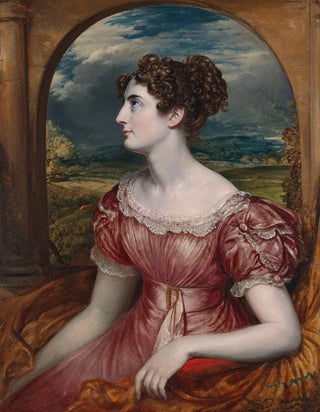Art print | Mademoiselle Puxley - John Linnell


View from behind

Frame (optional)
In the world of art, some works manage to capture the essence of their era while transcending the limits of time. "Mademoiselle Puxley" by John Linnell is a shining example of this alchemy. Painted in the 19th century, this piece does more than depict a female figure; it evokes emotions, stories, and atmospheres that still resonate today. The delicacy of Mademoiselle Puxley's features, along with the subtlety of the colors, immerses us in a universe where intimacy and contemplation reign. Observing this piece, one cannot help but feel a deep connection with the subject, an invitation to explore the nuances of her character and her time.
Style and uniqueness of the work
The uniqueness of "Mademoiselle Puxley" lies in John Linnell's technical mastery, which manages to blend realism and romanticism. Every detail, from the delicate fabric of the dress to the expressions of gentle melancholy, demonstrates meticulous attention to the representation of the human figure. Linnell excels in the use of light, creating a play of shadows and reflections that gives unparalleled depth to his subject. The choice of colors, both vivid and soft, helps establish an atmosphere of serenity and elegance. Contemplating this piece, one perceives a harmony between the subject and her environment, a subtle interaction that makes this painting a true masterpiece. The composition is thoughtfully designed, with each element arranged to guide the eye toward the center of the work, where Mademoiselle Puxley's figure seems to come to life.
The artist and his influence
John Linnell, a British artist of the 19th century, is often regarded as one of the masters of portraiture. His artistic journey is marked by a deep admiration for nature and humanity, themes he captured with a unique sensitivity. Influenced by the Pre-Raphaelites and Romanticism, Linnell developed a style that is his own, blending academic rigor with a freer, more intuitive approach. His artistic vision goes beyond

Matte finish

View from behind

Frame (optional)
In the world of art, some works manage to capture the essence of their era while transcending the limits of time. "Mademoiselle Puxley" by John Linnell is a shining example of this alchemy. Painted in the 19th century, this piece does more than depict a female figure; it evokes emotions, stories, and atmospheres that still resonate today. The delicacy of Mademoiselle Puxley's features, along with the subtlety of the colors, immerses us in a universe where intimacy and contemplation reign. Observing this piece, one cannot help but feel a deep connection with the subject, an invitation to explore the nuances of her character and her time.
Style and uniqueness of the work
The uniqueness of "Mademoiselle Puxley" lies in John Linnell's technical mastery, which manages to blend realism and romanticism. Every detail, from the delicate fabric of the dress to the expressions of gentle melancholy, demonstrates meticulous attention to the representation of the human figure. Linnell excels in the use of light, creating a play of shadows and reflections that gives unparalleled depth to his subject. The choice of colors, both vivid and soft, helps establish an atmosphere of serenity and elegance. Contemplating this piece, one perceives a harmony between the subject and her environment, a subtle interaction that makes this painting a true masterpiece. The composition is thoughtfully designed, with each element arranged to guide the eye toward the center of the work, where Mademoiselle Puxley's figure seems to come to life.
The artist and his influence
John Linnell, a British artist of the 19th century, is often regarded as one of the masters of portraiture. His artistic journey is marked by a deep admiration for nature and humanity, themes he captured with a unique sensitivity. Influenced by the Pre-Raphaelites and Romanticism, Linnell developed a style that is his own, blending academic rigor with a freer, more intuitive approach. His artistic vision goes beyond






